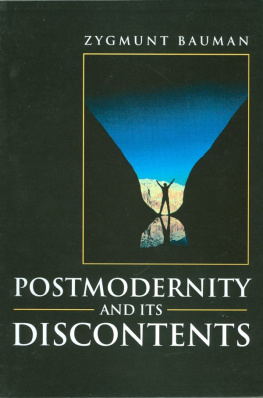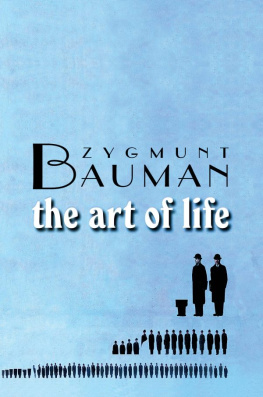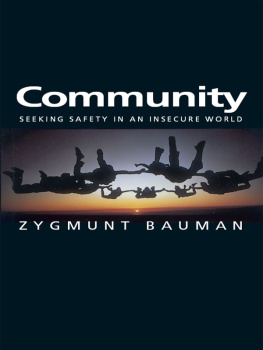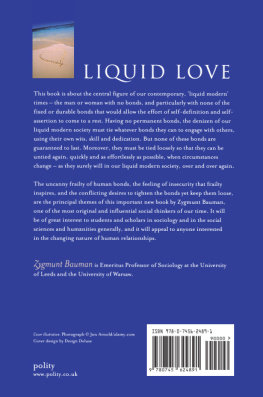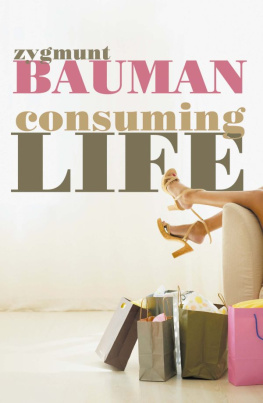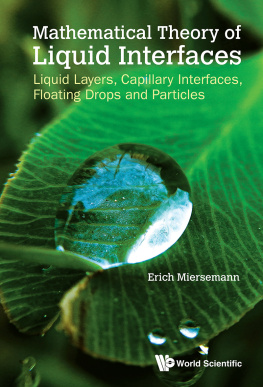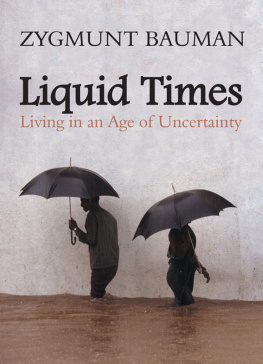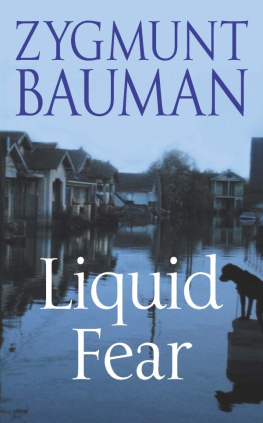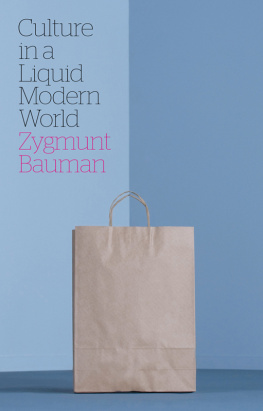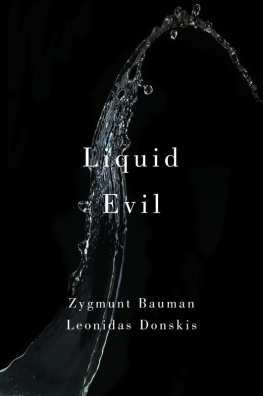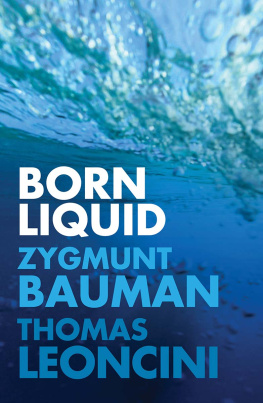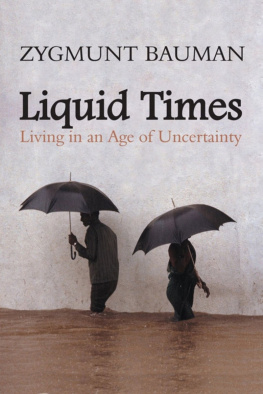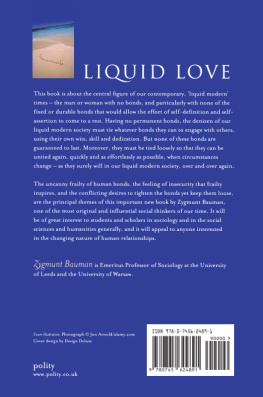The right of Zygmunt Bauman to be identified as Author of this Work has been asserted in accordance with the UK Copyright, Designs and Patents Act 1988.
All rights reserved. Except for the quotation of short passages for the purposes of criticism and review, no part of this publication may be reproduced, stored in a retrieval system, or transmitted, in any form or by any means, electronic, mechanical, photocopying, recording or otherwise, without the prior permission of the publisher.
A catalogue record for this book is available from the British Library and has been applied for from the Library of Congress.
Introduction: On Living in a Liquid Modern World
In skating over thin ice, our safety is in our speed.
Ralph Waldo Emerson, On Prudence
Liquid life and liquid modernity are intimately connected. Liquid life is a kind of life that tends to be lived in a liquid modern society. Liquid modern is a society in which the conditions under which its members act change faster than it takes the ways of acting to consolidate into habits and routines. Liquidity of life and that of society feed and reinvigorate each other. Liquid life, just like liquid modern society, cannot keep its shape or stay on course for long.
In a liquid modern society, individual achievements cannot be solidified into lasting possessions because, in no time, assets turn into liabilities and abilities into disabilities. Conditions of action and strategies designed to respond to them age quickly and become obsolete before the actors have a chance to learn them properly. Learning from experience in order to rely on strategies and tactical moves deployed successfully in the past is for that reason ill advised: past tests cannot take account of the rapid and mostly unpredicted (perhaps unpredictable) changes in circumstances. Extrapolating from past events to predict future trends becomes ever more risky and all too often misleading. Trustworthy calculations are increasingly difficult to make, while foolproof prognoses are all but unimaginable: most if not all variables in the equations are unknown, whereas no estimates of their future trends can be treated as fully and truly reliable.
In short: liquid life is a precarious life, lived under conditions of constant uncertainty. The most acute and stubborn worries that haunt such a life are the fears of being caught napping, of failing to catch up with fast-moving events, of being left behind, of overlooking use by dates, of being saddled with possessions that are no longer desirable, of missing the moment that calls for a change of tack before crossing the point of no return. Liquid life is a succession of new beginnings yet precisely for that reason it is the swift and painless endings, without which new beginnings would be unthinkable, that tend to be its most challenging moments and most upsetting headaches. Among the arts of liquid modern living and the skills needed to practise them, getting rid of things takes precedence over their acquisition.
As the Observer cartoonist Andy Riley puts it, the annoyance is reading articles about the wonders of downshifting when you havent even managed to upshift yet. One needs to hurry with the upshifting if one wants to taste the delights of downshifting. Getting the site ready for downshifting bestows meaning on the upshifting bit, and becomes its main purpose; it is by the relief brought by a smooth and painless downshifting that the quality of upshifting will be ultimately judged
The briefing which the practitioners of liquid modern life need most (and are most often offered by the expert counsellors in the life arts) is not how to start or open, but how to finish or close. Another Observer columnist, with a tongue only halfway to his cheek, lists the updated rules for achieving closure of partnerships (the episodes no doubt more difficult to close than any other yet the ones where the partners all too often wish and fight to close them, and so where there is unsurprisingly a particularly keen demand for expert help). The list starts from Remember bad stuff. Forget the good and ends with Meet someone new, passing midway the command Delete all electronic correspondence. Throughout, the emphasis falls on forgetting, deleting, dropping and replacing.
Perhaps the description of liquid modern life as a series of new beginnings is an inadvertent accessory to a conspiracy of sorts; by replicating a commonly shared illusion it helps to hide its most closely guarded (since shameful, if only residually so) secret. Perhaps a more adequate way to narrate that life is to tell the story of successive endings . And perhaps the glory of the successfully lived liquid life would be better conveyed by the inconspicuousness of the graves that mark its progress than by the ostentation of gravestones that commemorate the contents of the tombs.
In a liquid modern society, the waste-disposal industry takes over the commanding positions in liquid lifes economy. The survival of that society and the well-being of its members hang on the swiftness with which products are consigned to waste and the speed and efficiency of waste removal. In that society nothing may claim exemption from the universal rule of disposability, and nothing may be allowed to outstay its welcome. The steadfastness, stickiness, viscosity of things inanimate and animate alike are the most sinister and terminal of dangers, sources of the most frightening of fears and the targets of the most violent of assaults.
Life in a liquid modern society cannot stand still. It must modernize (read: go on stripping itself daily of attributes that are past their sell-by dates and go on dismantling/shedding the identities currently assembled/put on) or perish. Nudged from behind by the horror of expiry, life in a liquid modern society no longer needs to be pulled forward by imagined wonders at the far end of modernizing labours. The need here is to run with all ones strength just to stay in the same place and away from the rubbish bin where the hindmost are doomed to land.
Creative destruction is the fashion in which liquid life proceeds, but what that term glosses over and passes by in silence is that what this creation destroys are other forms of life and so obliquely the humans who practise them. Life in the liquid modern society is a sinister version of the musical chairs game, played for real. The true stake in the race is (temporary) rescue from being excluded into the ranks of the destroyed and avoiding being consigned to waste. And with the competition turning global, the running must now be done round a global track.
The greatest chances of winning belong to the people who circulate close to the top of the global power pyramid, to whom space matters little and distance is not a bother; people at home in many places but in no one place in particular. They are as light, sprightly and volatile as the increasingly global and extraterritorial trade and finances that assisted at their birth and sustain their nomadic existence. As Jacques Attali described them, they do not own factories, lands, nor occupy administrative positions. Their wealth comes from a portable asset: their knowledge of the laws of the labyrinth. They love to create, play and be on the move. They live in a society of volatile values, carefree about the future, egoistic and hedonistic. They take novelty as good tidings, precariousness as value, instability as imperative, hybridity as richness. In varying degrees, they all master and practise the art of liquid life: acceptance of disorientation, immunity to vertigo and adaptation to a state of dizziness, tolerance for an absence of itinerary and direction, and for an indefinite duration of travel.


